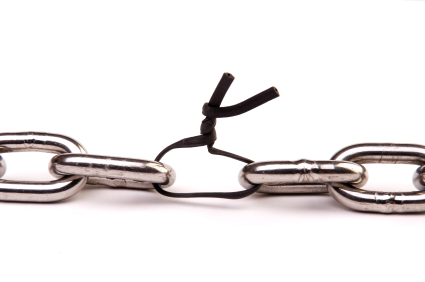Leaders – Who Sets The Standards?
My boss had some pretty high standards. In fact, he often bragged that his standards were higher than those of his peers.
When I came onto the team, I liked his approach. I truly believed that a leader who set high standards got more out of people and had better teams. I was wrong, and he was wrong.
Unfortunately, I learned that my view and his view of standards were too simplistic. That team was average despite his high standards. Why? His high standards were not the team’s real standards.
Who Sets The Standards?
Leaders do not determine what the team standards are, the worst performing team member does. The old saying applies:
“A chain is only as strong as it’s weakest link.”
Just because I say I have high standards does not make it so. Just like claiming to be a man of integrity does not make me one. The key to both is my actions.
If a leader leaves the weak link alone that weak link sets the real standard for the team. Just like a man’s willingness to lie when he is late for work proves he is not a man of integrity.
What actions should I take to ensure my standards are in fact the team’s standards?
Defining Standards
Standards are not goals. Standards are minimums. They are the lowest bar someone must clear to be a productive part of the team.
I must be sure my team understands this point and doesn’t settle for less.
Set High Standards
Wherever the bar is set, people tend to clear it. In the Olympic high jump competition, even the world’s best jump only as high as they need to clear the bar.
Set a low bar and they clear it. Set a high one, and they clear that as well. But, it is the high bar that wins them the gold!
Communicate The Standards
Standards are not like self guided missiles. You don’t shoot them and forget. When a leader sets standards, those standards need to be over-communicated and clarified frequently.
Enforce The Standards
This is often the biggest shortfall for leaders. Standards without enforcement default to the performance of the lowest common denominator – the weak link.
Without enforcement, the formerly high standards of others on the team will begin to slip as well. Even if they do maintain their own high standards, the top performers will resent the inconsistency of the leader.
The leader will lose the respect of his best people because he is unwilling to hold his weakest people to the minimum expectations. Does anyone else see the futility in that scenario?
Coach The Standards
When a person is not performing to the standards, it is the leader’s responsibility to coach that person to get them up to speed.
A leader who ignores either situation is not doing his job. The leader’s job is to strengthen the weak link. If the team has a list of 5 team standards and a person is unwilling or unable to perform all 5 to the standards the leader sets, then the leader must act.
The leader should provide both the training and the motivation until he realizes he is working harder at them achieving the standards than they are. Then it is time for the next step.
Fire If Below Standard
Once the leader realizes the person is unable or unwilling to meet the standards of the team, the leader has a responsibility to the team to fire the weak link and hire a stronger one.
The Bottom Line:
Claiming high standards is only the first step in leading a team with high standards. The leader must have the Courage, the determination and the Integrity to ensure the standards are his and not those of his weakest link.
As a leader, I must own my standards and take responsibility for the people I hired who are failing to meet my standards. If I am not willing to do that, I am allowing my poorest performer to do my job! The weakest link is setting the standards, not me.
Question:
Have you ever seen a weak link bring down the standards of a high performing team?
Dave Anderson is coauthor of the Amazon Best-Seller Becoming a Leader of Character – Six Habits that Make or Break a Leader at Work and at Home with his father General James L. Anderson (USA Retired).
You can order Becoming a Leader of Character on Amazon by clicking here:
You can also find Becoming a Leader of Character at Barnes and Noble, Books-a-Million and other retailers.


Dave – great quote: “Leaders do not determine what the team standards are, the worst performing team member does.” You raise a very good point that while the leaders do set the standard, they set it based on what they allow from the lowest performer.
Thanks Brad. Well said: “They set it based upon what they allow from the lowest performer.”
“A chain is only as strong as it’s weakest link.” is a thoroughly inadequate analogy for the complex “organic” nature of an organization.
Perhaps more appropriate would be that of a rope, in that it is the way in which the various strands interact and combine which determines the overall strength, and strands support each other – again an inadequate analogy, as strands in an organization can actively learn from, and progressively strengthen each other.
Or strands in a rope that are rotten can cause other strands to deteriorate?
Speed of the boss is speed of the crew! Set standards well understood by the team are a necessity, not a luxury, and should be emphasized, tracked and reinforced every day! A manager manages the problem-usually created by a lack of emphasis, a lack of direction and support on the part of the manager. A leader sets the pace. Every individual on the team understands not only where we are going, but how we are going to get there! Set standards, when implemented properly, act as the foundation for that success!
Well said Bruce! The leader displays his/her level of courage based on their willingness to enforce those standards.
As for most all industries producing goods and services the business owner(s) have regulatory or compliance requirements to meet, i.e. the standards. The good news is Supervision simply needs to find efficient ways in supporting these standards through communications/reinforcement and daily/weekly/yearly results tracking ( i.e. how are we doing feedback scorecards).
In my experience if these basic industry quality and safety standards are not supported by the boss these regulatory or compliance standards will become the failing links.
External, internal regulators/stakeholders sets our standards!
David, you are talking about one type of standards. What about behaviorial standards that are not based upon regulatory or compliance requirements? You hit it right on the head in your second paragraph. “If those standards are not supported by the boss ‘Behavior Standards’ will become failed links.”